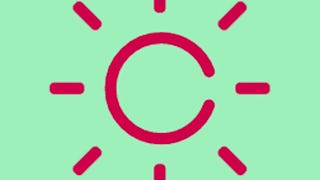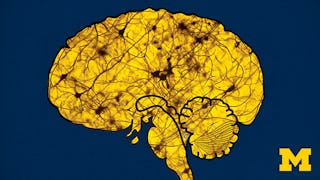Light is one of our most valuable resources on this earth. It makes the world visible to us, is the major driver of the 24-hr sleep-wake cycle to which not only humans, but virtually all life on earth (fauna and flora) submits. In fact, there would be no life on earth without light. It is therefore hard to overestimate the impact light has on humans, biologically, psychologically, socially. And yet, we hardly ever think or speak about light.


Kompetenzen, die Sie erwerben
- Kategorie: Human Learning
- Kategorie: Systems Of Measurement
- Kategorie: Physics
- Kategorie: Biology
- Kategorie: Physiology
- Kategorie: Research Methodologies
- Kategorie: Psychology
- Kategorie: Scientific Visualization
- Kategorie: Human Factors
- Kategorie: Electrophysiology
Wichtige Details

Zu Ihrem LinkedIn-Profil hinzufügen
8 Aufgaben
Erfahren Sie, wie Mitarbeiter führender Unternehmen gefragte Kompetenzen erwerben.

In diesem Kurs gibt es 9 Module
Welcome to Course 2 of the LightCap project, titled "Basics of light and its effects on humans". This course explains the mechanisms through which light impacts human (psycho)physiology, and explains ways through which the light itself and the effects on us humans can be measured. It covers light as a physical phenomenon and introduces important psychological and chronobiological outcomes, how to measure them and how light acts on them. The basis of this course is a combination of physics, psychology and chronobiology.
Das ist alles enthalten
2 Videos4 Lektüren
In this first lecture, Vaida asks if you ever wonder how your memory or attention are doing? Or how your lighting environment can modulate how efficient you are at performing tasks or simply how you feel? There are many ways to measure cognitive abilities and various states. In this lecture we will dive into the various methods used in lighting research, going from performance tasks to common questionnaires. As we review the methods, we will briefly go back on the last 20+ years of research on how light can influence behaviour and/or health. Finally, and perhaps most importantly, the limits of each measurement will be discussed. With the help of this lecture, you will be able to: recognize and understand the measures often used in investigations, critically review them and apply them in your future research endeavours.
Das ist alles enthalten
3 Videos1 Aufgabe
In this lecture, Mahsa explains measures and CIE standards of light sources. Light is electromagnetic radiation that can be perceived by the human eye through some cells in the retina. Visible light has different wavelengths in the range of 400–700 nanometres (nm) with different intensity, frequency, and spectral power distribution. There are two basic types of light sources: natural light, the sun which is called daylight, and artificial light sources such as fluorescent lamps and LEDs. In this lecture, we will focus on the standardization of light sources in human life based on the International Commission on Illumination (CIE). We will talk about light metrology terms such as radiance, irradiance, luminance, and illuminance and learn how to measure different light sources and calculate light parameters to design light for a specific purpose.
Das ist alles enthalten
5 Videos1 Aufgabe
In this lecture, Mahsa will dive deeper into the human eye system and the sensitivity of different cells - photoreceptors- in it. We now know that there are three classes of photoreceptors in the human retina - cones, rods, and intrinsically photosensitive retinal ganglion cells (ipRGCs) expressing the photopigment melanopsin. Each of these photoreceptors differs in spectral sensitivity, temporal properties, and distribution across the retina. Since the discovery of ipRGCs we have developed new guidelines for light measurement. In this lecture, we will learn what alpha-opic and melanopic light measurements are and how we compute them. Last, Mahsa will explain the basics of metameric light.
Das ist alles enthalten
5 Videos1 Aufgabe
In lecture 4, Vaida discusses general psychophysiology in response to light. The environment, and in particular lighting conditions, do not always clearly affect human behaviour or the subjective answers to the questions: “Do you feel sleepy or alert?”, “How stressed are you feeling?”. However, that doesn’t imply that there are no effects. Indeed, some bodily responses can let us know if a light manipulation had an effect, or even improved our health. We look at hormones, investigate the frequency of heart beats, observe how pupils dilate and constrict and how eyes move, or study changes in electrodermal activity. In this lecture, we will oversee the psychophysiology in response to light manipulation, how signals are measured, processed, and interpreted. With this knowledge, you should be able to understand the main concepts in psychophysiology of light, and know which direction to go to if you want to consider physiology in your future studies.
Das ist alles enthalten
2 Videos1 Aufgabe
In this lecture, Elif introduces electroencephalography (EEG) – a means to measure brain activity on the scalp. EEG is one of the most widely used neuroimaging methods that give us insight into underlying electrophysiological processes in the brain. In this lecture, we will have a general introduction to EEG methods to objectively measure cognition and attention with examples from the application in the lighting domain. We will start learning about the nature of the EEG signals, brain oscillations, and concepts such as spectral power distributions. We will learn about Evoked Response Potentials (ERPs) and some of the most common forms of ERPs. We will learn about EEG Frequencies along with other ways to look at the EEG data sets.
Das ist alles enthalten
6 Videos1 Aufgabe
In this lecture, Elif will dive deeper into the analysis of electro-physiological data. She will talk about the role and importance of pre-processing of the EEG signals and go over the pipeline steps as it is very important for researchers to know what they are doing as they are clearing their data or conducting more sophisticated pre-processing. Later, we will look at the applications of this type of analysis in the lighting field while having examples from papers in the form of case studies. Examples will include topography pilots, ERP pilots, spectral density pilots, connectivity measures, etc. Lastly, we will briefly discuss about how to evaluate these plots from a critical perspective.
Das ist alles enthalten
3 Videos1 Aufgabe
In this lecture, Rafael discusses the importance of sleep and why we need to consider sleep in the lighting domain. You might have come across sentences like “blue light at night is bad for your sleep”. While the core message is clear, it is important to understand how and under what circumstances light can influence human sleep. In this lecture, we will explore light and its powerful trait as a “Zeitgeber”- a synchroniser for the “inner clock”. To understand the link between light and sleep we will 1) summarise the basics of sleep regulation, and circadian rhythms 2) briefly review measurement techniques of sleep and circadian rhythmicity 3) discuss implications for behavioural treatments of (circadian) sleep disorders.
Das ist alles enthalten
6 Videos1 Aufgabe
To close this course, Rafael discusses the link between light and sleep health in more depth. While ubiquitous in modern society, artificial light during the night can disrupt the “inner clock” and human sleep. However, recent empirical evidence suggests profound individual variation in these non-visual effects, which is rarely considered in real-life lighting settings. In this lecture we aim to 1) summarize essential non-visual effects of light 2) discuss how to assess non-visual light sensitivity 3) review individual factors that have been shown to influence non-visual light sensitivity (e.g., age, prior light history, chronotype) and 4) address implications for real-life setting.
Das ist alles enthalten
5 Videos1 Aufgabe
Dozent

Mehr von Psychology entdecken
 Status: Vorschau
Status: VorschauEindhoven University of Technology
 Status: Vorschau
Status: VorschauEindhoven University of Technology
 Status: Vorschau
Status: VorschauEindhoven University of Technology
 Status: Vorschau
Status: VorschauUniversity of Michigan
Warum entscheiden sich Menschen für Coursera für ihre Karriere?





Neue Karrieremöglichkeiten mit Coursera Plus
Unbegrenzter Zugang zu 10,000+ Weltklasse-Kursen, praktischen Projekten und berufsqualifizierenden Zertifikatsprogrammen - alles in Ihrem Abonnement enthalten
Bringen Sie Ihre Karriere mit einem Online-Abschluss voran.
Erwerben Sie einen Abschluss von erstklassigen Universitäten – 100 % online
Schließen Sie sich mehr als 3.400 Unternehmen in aller Welt an, die sich für Coursera for Business entschieden haben.
Schulen Sie Ihre Mitarbeiter*innen, um sich in der digitalen Wirtschaft zu behaupten.
Häufig gestellte Fragen
To access the course materials, assignments and to earn a Certificate, you will need to purchase the Certificate experience when you enroll in a course. You can try a Free Trial instead, or apply for Financial Aid. The course may offer 'Full Course, No Certificate' instead. This option lets you see all course materials, submit required assessments, and get a final grade. This also means that you will not be able to purchase a Certificate experience.
When you purchase a Certificate you get access to all course materials, including graded assignments. Upon completing the course, your electronic Certificate will be added to your Accomplishments page - from there, you can print your Certificate or add it to your LinkedIn profile.
Yes. In select learning programs, you can apply for financial aid or a scholarship if you can’t afford the enrollment fee. If fin aid or scholarship is available for your learning program selection, you’ll find a link to apply on the description page.
Weitere Fragen
Finanzielle Unterstützung verfügbar,

